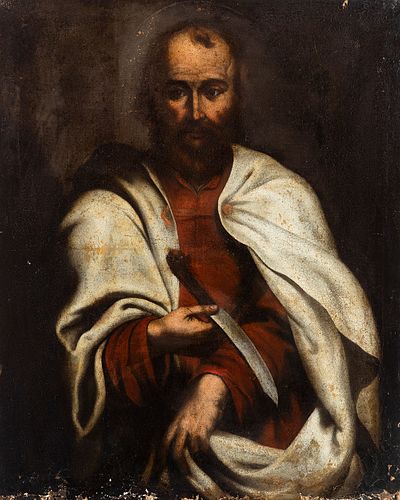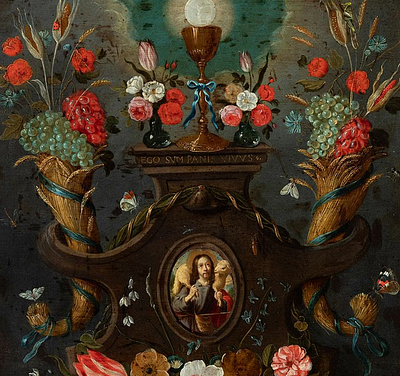Spanish school; 17th century. “San Bartolomé”. Oil on canvas. Relined.
Lot 49
About Seller
Setdart Auction House
Carrer Aragó 346
Barcelona
Spain
Setdart Subastas was born in 2004 and is currently the first online art auction in Spain with solidity, prestige and reliability guaranteed by our more than 60,000 users. Setdart has a young, dynamic and enterprising team ready to successfully manage the purchase and sale of art works through custom...Read more
Estimate:
EUR€1,500 - EUR€2,000
$1,578.95 - $2,105.26
Absentee vs Live bid
Two ways to bid:
- Leave a max absentee bid and the platform will bid on your behalf up to your maximum bid during the live auction.
- Bid live during the auction and your bids will be submitted real-time to the auctioneer.
Bid Increments
| Price | Bid Increment |
|---|---|
| EUR€0 | EUR€10 |
| EUR€200 | EUR€25 |
| EUR€500 | EUR€50 |
| EUR€1,000 | EUR€100 |
| EUR€3,000 | EUR€200 |
| EUR€5,000 | EUR€500 |
| EUR€10,000 | EUR€1,000 |
| EUR€20,000 | EUR€2,000 |
| EUR€50,000 | EUR€5,000 |
About Auction
By Setdart Auction House
Sep 21, 2021
Set Reminder
2021-09-21 10:00:00
2021-09-21 10:00:00
America/New_York
Bidsquare
Bidsquare : 21st September - ARAS JÁUREGUI Private Collection - Old Masters, 19th & 20th Century
https://www.bidsquare.com/auctions/setdart-auction-house/21st-september---aras-j-uregui-private-collection---old-masters-19th-20th-century-7429
Setdart Auction House sofia@setdart.com
Setdart Auction House sofia@setdart.com
- Lot Description
Spanish school; 17th century. “San Bartolomé”. Oil on canvas. Relined. It presents faults and repainting. Measurements: 74,5 x 60,5 cm. Bartholomew was one of the apostles of Jesus, and he is mentioned in the Gospels always in the company of Philip. According to John, in whose Gospel he appears under the name of Nathanael, he was one of the disciples to whom Jesus appeared in the Sea of Tiberias after his resurrection. According to the Acts of the Apostles, he was also a witness to Jesus' ascension. The tradition recorded by Eusebius of Caesarea recounts that Bartholomew went to preach the Gospel in India, where he left a copy of Matthew's Gospel in Aramaic. Armenian tradition also attributes to him the preaching of Christianity in the Caucasus country, together with Saint Jude Thaddeus, and both are considered patron saints of the Armenian Apostolic Church. Their martyrdom and death are attributed to Astiages, king of Armenia and brother of King Polymius, whom the saint had converted to Christianity. When the priests of the pagan temples, who were running out of followers, protested to Astiages about Bartholomew's evangelising work, the ruler sent for him and ordered him to worship their idols, just as he had done with his brother. When the saint refused, the king ordered him to be flayed alive in his presence until he renounced God or died. The image of Saint Bartholomew has undergone few modifications throughout the history of art, and it is common to depict the saint at the moment of martyrdom. Thus, he is usually depicted being flayed, either on a rack or tied to a tree. He has also been depicted working miracles: resurrecting the sons of King Polymius and freeing his daughter, who was possessed by the devil. On rare occasions he is depicted being scourged. He is sometimes depicted with a large knife, alluding to his martyrdom, according to which he was flayed alive, which is why he is the patron saint of tanners. In connection with his martyrdom, he is also sometimes shown skinned, his skin being held on his arm as if it were a piece of clothing. The work has similarities in its composition and execution to some pieces by Francisco Herrera the Elder (Seville, 1573-1656), such as his work of Saint Peter, where a very similar treatment can be seen; the saint in the foreground, against an indeterminate background, portrayed with a long bust, holding his iconographic attribute. Francisco Herrera began his training alongside Francisco Pacheco, but Herrera soon broke with the timid style and Italian traditions of Spanish painting of his day, and became the pioneer of a bold, vigorous, effective and natural style. Herrera was the first to use long brushes, which may, in part, explain his "modern" technique and skilful brushstroke. His great talent brought him many pupils, whom his fiery temperament and rough manners soon drove away. Velázquez, at the age of thirteen, was placed in charge of this great teacher, and remained with him for a year. Herrera's paintings are full of energy, the drawing is impeccable and the colouring so skilfully handled that the figures stand out in splendid relief. Many of his small easel paintings, in oil, depict fairs, dances, inn interiors and deal with the intimate life of Spain. His large works are almost all religious. In Seville he painted a "Saint Peter" for the cathedral and a "Last Judgement" for the Church of San Bernardo, the latter being considered his masterpiece. After executing numerous commissions in his native city he moved to Madrid (1650), where he achieved great renown, but finally returned to Seville.
- Shipping Info
-
In-house shipping available. Please inquire at admin@setdart.com.
-
- Buyer's Premium



 EUR
EUR CAD
CAD AUD
AUD GBP
GBP MXN
MXN HKD
HKD CNY
CNY MYR
MYR SEK
SEK SGD
SGD CHF
CHF THB
THB















